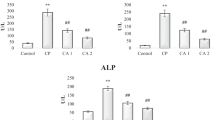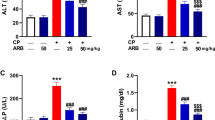Abstract
CP is one of the most widely used antineoplastic agents. However, its clinical application is very limited due to its severe toxic effects. The present study aimed to reveal the effects of NAC, which exhibits broad biological activities in reducing CP-induced liver damage, in consideration of biochemical, genetic, and histopathological findings. Twenty-eight wistar rats were randomly divided into four groups of seven animals. A dose of saline was administered (i.p.) to the control group for 5 days. One dose of NAC (200 mg/kg) was administered to the NAC group for 5 days (i.p.). To the NAC + CP group, a dose of CP (7.5 mg/kg) was administered on days 2 and 5 of the experiment, a dose of NAC (200 mg/ kg) (i.p.) was administered for 5 day of the experiment. CP (7.5 mg/kg) was administered to the CP group on days 2 and 5 of the experiment. At the end of the experiment, the biochemical, histological, and mRNA expression analyses of the liver tissues isolated from all the rats were performed. A statistically significant decrease was observed in the AST and ALT enzyme activities in Group NAC + CP compared to Control and CP groups. In addition, it was determined that the NAC administration reduced CP-induced inflammation by increasing the level of NF-κB and decreased CP-caused oxidative stress by decreasing the GPx level. Moreover, the histopathological analyses showed that NAC improved liver morphology. It was revealed by Western blotting analysis that NAC promoted Bcl-2 signaling and decreased p53 signaling. The findings herein showed that NAC could help alleviate hepatotoxicity, a serious therapeutic complication, by reducing CP-induced oxidative stress and playing an effective part in the regulation of apoptotic markers.




Similar content being viewed by others
References
Kaygusuzoglu E, Caglayan C, Kandemir FM, Yıldırım S, Kucukler S, Kılınc MA, Saglam YS (2018) Zingerone ameliorates cisplatin-induced ovarian and uterine toxicity via suppression of sex hormone imbalances, oxidative stress, inflammation and apoptosis in female wistar rats. Biomed & Pharmacother 102:517–530
Perše M, Večerić-Haler Ž (2018) Cisplatin-induced rodent model of kidney injury: characteristics and challenges. BioMed Res Int 2018
Alrashed AA, El-Kordy EA (2019) Possible protective role of panax ginseng on cisplatin-induced hepatotoxicity in adult male albino rats (Biochemical and Histological Study). J Microsc Ultrastruct 7(2):84
Omar HA, Mohamed WR, Arab HH, Arafa ESA (2016) Tangeretin alleviates cisplatin-induced acute hepatic injury in rats: targeting MAPKs and apoptosis. PLoS One 11(3):e0151649
Kadikoylu G, Bolaman Z, Demir S, Balkaya M, Akalin N, Enli Y (2004) The effects of desferrioxamine on cisplatin induced lipid peroxidation and the activities of antioxidant enzymes in rat kidneys. Hum Exp Toxicol 23(1):29–34
Hakiminia B, Goudarzi A, Moghaddas A (2019) Has vitamin E any shreds of evidence in cisplatin-induced toxicity. J Biochem Mol Toxicol 33(8):e22349
Sun Y, Yang J, Wang LZ, Sun LR, Dong Q (2014) Crocin attenuates cisplatin-induced liver injury in the mice. Hum Exp Toxicol 33(8):855–862
Hu L, Chen L, Li L, Sun H, Yang G, Chang Y, Wang H (2011) Hepatitis B virus X protein enhances cisplatin-induced hepatotoxicity via a mechanism involving degradation of Mcl-1. J Virol 85(7):3214–3228
Güntürk İ, Yazici C, Köse SK, Dağlı F, Yücel B, Yay AH (2019) The effect of N-acetylcysteine on inflammation and oxidativestress in cisplatin-induced nephrotoxicity: a rat model. Turk J Med Sci 49(6):1789–99
Bishr A, Sallam N, Nour El-Din M, Awad AS, Kenawy SA (2019) Ambroxol attenuates cisplatin-induced hepatotoxicity and nephrotoxicity via inhibition of p-JNK/p-ERK. Can J Physiol Pharmacol 97(1):55–64
Kim KY, Rhim T, Choi I, Kim SS (2001) N-acetylcysteine induces cell cycle arrest in hepatic stellate cells through its reducing activity. J Biol Chem 276(44):40591–40598
Kheradpezhouh E, Panjehshahin MR, Miri R, Javidnia K, Noorafshan A, Monabati A, Dehpour AR (2010) Curcumin protects rats against acetaminophen induced hepatorenal damages and shows synergistic activity with N-acetylcysteine. J Pharmacol 628(1–3):274–281
Atasayar S, Gürer-Orhan H, Orhan H, Gürel B, Girgin G, Özgüneş H (2009) Preventive effect of amino guanidine compared to vitamin E and C on cisplatin-induced nephrotoxicity in rats. Exp Toxicol Pathol 61(1):23–32
Kaya H, Polat B, Albayrak A, Mercantepe T, Buyuk B (2018) Protective effect of an L-type calcium channel blocker, amlodipine, on paracetamol-induced hepatotoxicity in rats. Hum Exp Toxicol 37(11):1169–1179
Oztopuz O, Turkon H, Buyuk B, Coskun O, Sehitoglu MH, Ovali MA, Uzun M (2020) Melatonin ameliorates sodium valproate-induced hepatotoxicity in rats. Mol Biol Rep 47(1):317–325
Ayla Ş, Oktar H, Tanrıverdi G, Cengiz M, Özkılıç AÇ, Can G, Batur Ş (2009) Doksorubisin nedenli sıçan hepatotoksisitesine nikotinamidin (koruyucu) etkisi. Anadolu University Journal of Sciences & Technology 10(1)
Güntürk I, Yazici C, Köse SK, Dağlı F, Yücel B, Yay AH (2019) The effect of N-acetylcysteine on inflammation and oxidative stress in cisplatin-induced nephrotoxicity: a rat model. Turk J Med Sci 49(6):1789–1799
Ghosh S (2019) Cisplatin: The first metal based anticancer drug. Bioorg Chem 88:102925
Abd Rashid N, Hussan F, Hamid A, Ridzuan NRA, Lin TS, Budin SB (2019) Preventive effects of polygonum minus essential oil on cisplatin-induced hepatotoxicity in sprague Dawley Rats. Sains Malaysiana 48(9):1975–1988
Kim SH, Hong KO, Chung WY, Hwang JK, Park KK (2004) Abrogation of cisplatin-induced hepatotoxicity in mice by xanthorrhizol is related to its effect on the regulation of gene transcription. Toxicol Appl Pharmacol 196(3):346–355
Karadeniz A, Simsek N, Karakus E, Yildirim S, Kara A, Can I, Kisa E, Emre H, Turkeli M (2011) Royal jelly modulates oxidative stress and apoptosis in liver and kidneys of rats treated with cisplatin. Oxid Med Cell Longev 2011
Mansour HH, Hafez HF, Fahmy NM (2006) Silymarin modulates cisplatin-induced oxidative stress and hepatotoxicity in rats. BMB Reports 39(6):656–661
Erenel G, Erbaş D, Arıcıoğlu A (1992) Serbest radikaller ve antioksidan sistemler. Gazi Med J 3(4)
Arab HH, Mohamed WR, Barakat BM, Arafa ESA (2016) Tangeretin attenuates cisplatin-induced renal injury in rats: impact on the inflammatory cascade and oxidative perturbations. Chem Biol Interact 258:205–213
Nasr AY (2014) Protective effect of aged garlic extract against the oxidative stress induced by cisplatin on blood cells parameters and hepatic antioxidant enzymes in rats. Toxicol Rep 1:682–691
Bentli R, Parlakpinar H, Polat A, Samdanci E, Sarihan ME, Sagir M (2013) Molsidomine prevents cisplatin-induced hepatotoxicity. Arch Med Res 44(7):521–528
Aydoğdu N, Kaymak K, Yalçın Ö (2005) Sıçanlarda Böbrek İskemi/Reperfüzyon Hasarında N-Asetilsisteinin Etkileri. Fırat Tıp Dergisi 10(4):151–155
Thong-Ngam D, Samuhasaneeto S, Kulaputana O, Klaikeaw N (2007) N-acetylcysteine attenuates oxidative stress and liver pathology in rats with non-alcoholic steatohepatitis. World J Gastroenterol 13(38):5127
Lingappan K (2018) NF-κB in oxidative stress. Curr Opin Toxicol 7:81–86
Reyes-Gordillo K, Segovia J, Shibayama M, Vergara, P, Moreno MG, Muriel P (2007) Curcumin protects against acute liver damage in the rat by inhibiting NF-κB, proinflammatory cytokines production and oxidative stress. Biochim Biophys Acta (BBA) Gen Subj 1770(6): 989-996
Hayakawa M, Miyashita H, Sakamoto I, Kitagawa M, Tanaka H, Yasuda H, Kikugawa K (2003) Evidence that reactive oxygen species do not mediate NF-κB activation. EMBO J 22(13):3356–3366
Huang S, You J, Wang K, Li Y, Zhang Y, Wei H, Liu Y (2019) N-acetylcysteine attenuates cisplatin-induced acute kidney injury by inhibiting the C5a receptor. BioMed Res Int 2019
Kandemir FM, Yildirim S, Caglayan C, Kucukler S, Eser G (2019) Protective effects of zingerone on cisplatin-induced nephrotoxicity in female rats. Environ Sci Pollut Res 26(22):22562–22574
Koc A, Duru M, Ciralik H, Akcan R, Sogut S (2005) Protective agent, erdosteine, against cisplatin-induced hepatic oxidant injury in rats. Mol Cell Biochem 278(1–2):79–84
İşeri S, Ercan F, Gedik N, Yüksel M, Alican I (2007) Simvastatin attenuates cisplatin-induced kidney and liver damage in rats. Toxicology 230(2–3):256–264
Acknowledgements
This study was financially supported by the Office of Scientific Research Projects, Çanakkale Onsekiz Mart University (Project Number: TSA-2019-2856).
Author information
Authors and Affiliations
Corresponding author
Ethics declarations
Conflict of interest
The authors declared no Conflict of interest.
Ethical approval
This study was approved by the animal ethics committee of Çanakkale Onsekiz Mart University in accordance with ethical guidelines for the Care and Use of Laboratory Animals. (Decision No: 2020/01-01).
Additional information
Publisher's Note
Springer Nature remains neutral with regard to jurisdictional claims in published maps and institutional affiliations.
Rights and permissions
About this article
Cite this article
Coşkun, Ö., Öztopuz, Ö. & Büyük, B. Possible protective activity of n-acetyl cysteine against cisplatin‑induced hepatotoxicity in rats. Mol Biol Rep 48, 637–644 (2021). https://doi.org/10.1007/s11033-020-06111-0
Received:
Accepted:
Published:
Issue Date:
DOI: https://doi.org/10.1007/s11033-020-06111-0




